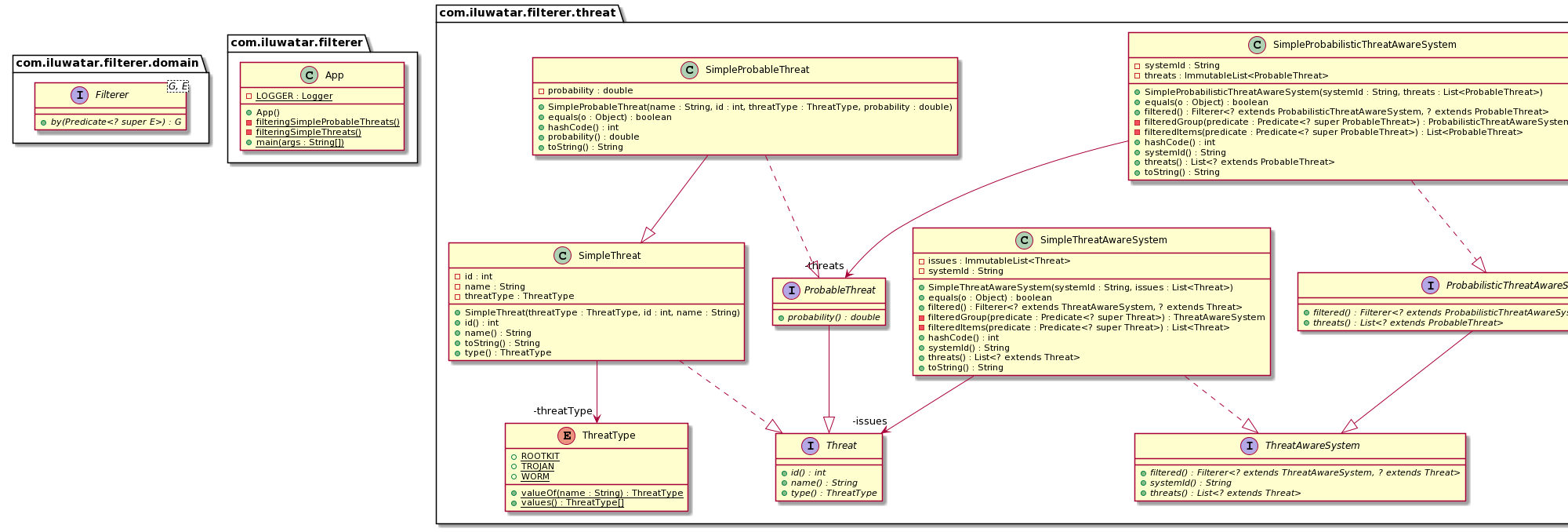--- # this is so called 'Yaml Front Matter', read up on it here: http://jekyllrb.com/docs/frontmatter/ layout: pattern title: Filterer folder: filterer permalink: /patterns/filterer/ description: Design pattern that helps container-like objects to return filtered version of themselves.# short meta description that shows in Google search results categories:
- Functional tags:
- Extensibility
Name / classification
Filterer
Intent
The intent of this design pattern is to to introduce a functional interface that will add a functionality for container-like objects to easily return filtered versions of themselves.
Explanation
Real world example
We are designing a threat(malware) detection system. We can have different types of threats and systems. We have a requirement that system should be aware of threats that are present in it. In the design we have to take into consideration that new Threat types can be added later. Also there is a requirement that a system can filter itself based on the threats that it possesses (system acts as container-like object for threats).
In plain words
We need to be able to filter different types of systems(container-like objects) based on properties of Threats that they contain. Adding new properties for Threats should be easy (we still need the ability to filter by those new properties).
Programmatic Example
To model the threat detection example presented above we introduce Threat and ThreatAwareSystem interfaces.
public interface Threat {
String name();
int id();
ThreatType type();
}
public interface ThreatAwareSystem {
String systemId();
List<? extends Threat> threats();
Filterer<? extends ThreatAwareSystem, ? extends Threat> filtered();
}
Notice the filtered method that returns instance of Filterer interface which is defined as :
@FunctionalInterface
public interface Filterer<G, E> {
G by(Predicate<? super E> predicate);
}
it is used to fulfill the requirement for system to be able to filter itself based on threat properties.
The container-like object (ThreatAwareSystem in our case) needs to have a method that returns an instance of Filterer. This helper interface gives
ability to covariantly specify a lower bound of contravariant Predicate in the subinterfaces of interfaces representing the container-like objects.
In our example we will be able to pass a predicate that takes ? extends Threat object and return ? extends ThreatAwareSystem
from Filtered::by method. A simple implementation of ThreadAwareSystem :
public class SimpleThreatAwareSystem implements ThreatAwareSystem {
private final String systemId;
private final ImmutableList<Threat> issues;
public SimpleThreatAwareSystem(final String systemId, final List<Threat> issues) {
this.systemId = systemId;
this.issues = ImmutableList.copyOf(issues);
}
@Override
public String systemId() {
return systemId;
}
@Override
public List<? extends Threat> threats() {
return new ArrayList<>(issues);
}
@Override
public Filterer<? extends ThreatAwareSystem, ? extends Threat> filtered() {
return this::filteredGroup;
}
private ThreatAwareSystem filteredGroup(Predicate<? super Threat> predicate) {
return new SimpleThreatAwareSystem(this.systemId, filteredItems(predicate));
}
private List<Threat> filteredItems(Predicate<? super Threat> predicate) {
return this.issues.stream()
.filter(predicate)
.collect(Collectors.toList());
}
}
the filtered method is overridden to filter the threats list by given predicate.
Now if we introduce new subtype of Thread interface that adds probability with which given thread can appear :
public interface ProbableThreat extends Threat {
double probability();
}
we can also introduce a new interface that represents a system that is aware of threats with their probabilities :
public interface ProbabilisticThreatAwareSystem extends ThreatAwareSystem {
@Override
List<? extends ProbableThreat> threats();
@Override
Filterer<? extends ProbabilisticThreatAwareSystem, ? extends ProbableThreat> filtered();
}
Notice how we override the filtered method in ProbabilisticThreatAwareSystem and specify different return covariant type
by specifing different generic types. Our interfaces are clean and not cluttered by default implementations. We
we will be able to filter ProbabilisticThreatAwareSystem by ProbableThreat properties :
public class SimpleProbabilisticThreatAwareSystem implements ProbabilisticThreatAwareSystem {
private final String systemId;
private final ImmutableList<ProbableThreat> threats;
public SimpleProbabilisticThreatAwareSystem(final String systemId, final List<ProbableThreat> threats) {
this.systemId = systemId;
this.threats = ImmutableList.copyOf(threats);
}
@Override
public String systemId() {
return systemId;
}
@Override
public List<? extends ProbableThreat> threats() {
return threats;
}
@Override
public Filterer<? extends ProbabilisticThreatAwareSystem, ? extends ProbableThreat> filtered() {
return this::filteredGroup;
}
private ProbabilisticThreatAwareSystem filteredGroup(final Predicate<? super ProbableThreat> predicate) {
return new SimpleProbabilisticThreatAwareSystem(this.systemId, filteredItems(predicate));
}
private List<ProbableThreat> filteredItems(final Predicate<? super ProbableThreat> predicate) {
return this.threats.stream()
.filter(predicate)
.collect(Collectors.toList());
}
}
Now if we want filter ThreatAwareSystem by threat type we can do :
Threat rootkit = new SimpleThreat(ThreatType.ROOTKIT, 1, "Simple-Rootkit");
Threat trojan = new SimpleThreat(ThreatType.TROJAN, 2, "Simple-Trojan");
List<Threat> threats = List.of(rootkit, trojan);
ThreatAwareSystem threatAwareSystem = new SimpleThreatAwareSystem("System-1", threats);
ThreatAwareSystem rootkitThreatAwareSystem = threatAwareSystem.filtered()
.by(threat -> threat.type() == ThreatType.ROOTKIT);
or if we want to filter ProbabilisticThreatAwareSystem :
ProbableThreat malwareTroyan = new SimpleProbableThreat("Troyan-ArcBomb", 1, ThreatType.TROJAN, 0.99);
ProbableThreat rootkit = new SimpleProbableThreat("Rootkit-System", 2, ThreatType.ROOTKIT, 0.8);
List<ProbableThreat> probableThreats = List.of(malwareTroyan, rootkit);
ProbabilisticThreatAwareSystem simpleProbabilisticThreatAwareSystem =new SimpleProbabilisticThreatAwareSystem("System-1", probableThreats);
ProbabilisticThreatAwareSystem filtered = simpleProbabilisticThreatAwareSystem.filtered()
.by(probableThreat -> Double.compare(probableThreat.probability(), 0.99) == 0);
Class diagram
Applicability
Pattern can be used when working with container-like objects that use subtyping, instead of parametrizing(generics) for extensible class structure. It enables you to easily extend filtering ability of container-like objects as business requirements change.
Tutorials
- Article about Filterer pattern posted on it's author's blog
- Application of Filterer pattern in domain of text analysis
Known uses
One of the uses is present on the blog presented in this link.
It presents how to use Filterer pattern to create text issue analyzer with support for test cases used for unit testing.
Consequences
Pros :
- you can easily introduce new subtypes for container-like objects and subtypes for objects that are contained within them and still be able to filter easily be new properties of those new subtypes.
Cons :
- covariant return types mixed with generics can be sometimes tricky
Credits
- Author of the pattern : Tomasz Linkowski
